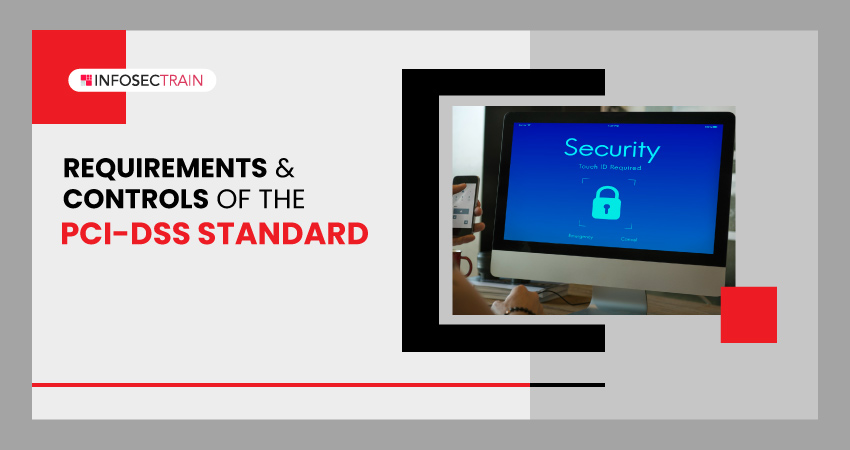Requirements and Controls of the PCI-DSS Standard
Security breaches have become an unfortunate norm in today’s digital landscape, and sensitive data is at constant risk. To combat this menace and protect the integrity of payment card transactions which are a vital component of our modern economy, the Payment Card Industry Data Security Standard (PCI-DSS) was born. This standard sets stringent guidelines for organizations handling payment card data, ensuring their compliance with robust security measures.

PCI-DSS is not just a compliance framework but a formidable shield against cyber threats, ensuring that organizations handling payment card data adhere to stringent security measures. Let’s learn more about it.
The Foundation of PCI-DSS: Protecting Cardholder Data
At its core, PCI-DSS is built around one crucial objective: safeguarding cardholder data. To achieve this, PCI-DSS sets forth a comprehensive framework that organizations must adhere to.
The standard comprises twelve key requirements, divided into six control objectives, each designed to address specific aspects of data security.
Control Objective 1: Build and Maintain a Secure Network and Systems
Requirement 1: Install and maintain a firewall configuration to protect cardholder data
The inaugural requirement revolves around creating and maintaining a robust firewall configuration. By doing so, organizations fortify their defenses against unauthorized access, ensuring cardholder data security.
Requirement 2: Do not use vendor-supplied defaults for system passwords and other security parameters
The use of default settings or passwords provided by vendors is a glaring vulnerability. Requirement 2 underscores the importance of personalizing these settings to bolster security.
Control Objective 2: Protect Cardholder Data
Requirement 3: Protect stored cardholder data
To safeguard sensitive cardholder data, organizations must employ encryption for stored information, rendering it indecipherable to potential threats.
Requirement 4: Encrypt the transmission of cardholder data across open, public networks
Encryption is paramount when transmitting cardholder data across public networks. Requirement 4 ensures that data remains confidential during its journey.
Control Objective 3: Maintain a Vulnerability Management Program
Requirement 5: Protect all systems against malware and regularly update anti-virus software or programs
Anti-virus software stands as a vital defense against malicious software. Requirement 5 mandates its implementation and frequent updates to ward off emerging threats.
Requirement 6: Develop and maintain secure systems and applications
Insecure systems and software are potential weak links. Requirement 6 underscores the significance of secure development practices and ongoing system maintenance.
Control Objective 4: Implement Strong Access Control Measures
Requirement 7: Restrict access to cardholder data by business need to know
Not everyone within an organization should have access to cardholder data. Requirement 7 stresses the importance of restricting access to those with a legitimate business need.
Requirement 8: Identify and authenticate access to system components
Assigning unique user IDs fosters accountability and facilitates access monitoring. Requirement 8 makes this practice a mandate.
Requirement 9: Restrict physical access to cardholder data
Physical security of data cannot be undermined, it is as important as digital security. Requirement 9 focuses on limiting physical access to data and systems.
Control Objective 5: Regularly Monitor and Test Networks
Requirement 10: Track and monitor all access to network resources and cardholder data
Continuous monitoring and comprehensive logging of network access play a pivotal role in early threat detection and swift response. Requirement 10 emphasizes this practice’s significance.
Requirement 11: Regularly test security systems and processes
Organizations must regularly subject their security systems to testing. Requirement 11 necessitates vulnerability assessments and penetration testing.
Control Objective 6: Maintain an Information Security Policy
Requirement 12: Maintain a policy that addresses information security for all personnel
Lastly, a comprehensive organization-wide information security policy is imperative. Requirement 12 ensures that every organization member is well-versed in and compliant with security policies.
In Conclusion: Upholding the PCI-DSS Shield
PCI-DSS is not merely a compliance checklist; it’s a comprehensive security framework that, when diligently followed, forms a formidable defense against data breaches. By understanding and adhering to its core requirements and controls, organizations can protect the confidentiality and integrity of payment card data.
However, achieving and maintaining PCI-DSS compliance is no small feat. It requires continuous effort, expertise, and resources. That’s where organizations like InfosecTrain come into play, offering specialized training and guidance to navigate the intricacies of PCI-DSS compliance. With a solid understanding of the standard’s requirements and controls and expert guidance, organizations can stand firm against the ever-present threat of cybercrime, securing the future of payment card transactions.




 1800-843-7890 (IN)
1800-843-7890 (IN) sales@infosectrain.com
sales@infosectrain.com
 1800-843-7890 (India)
1800-843-7890 (India) 
